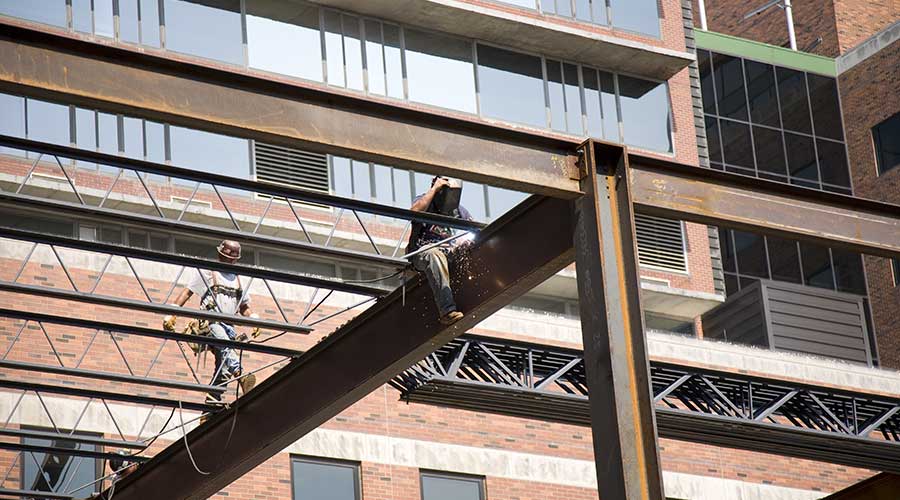At any hospital on any given day, at least one construction project is underway. More likely, several simultaneous projects are in various stages of completion. This situation is inevitable because hospitals need to constantly remodel and reconfigure spaces to accommodate new equipment and the expansion or upgrade of labs, patient rooms and specialty care units.
Since it is nearly impossible to shut down an area in a hospital, the construction crew responsible for the project must have specific healthcare expertise to maintain the facility’s operations without disrupting patient care. This requirement involves a deep understanding of activities such as operational workflows, fire-life safety code standards, building infrastructure capacities, schedule constraints, safety protocols, infection control measures, jurisdictional permitting and ways to navigate multi-departmental hospitals signoffs. It also means that everybody on the jobsite needs to be fully vetted and understand their role.
Since the general contractor (GC) is responsible for everybody and everything that happens on a hospital construction project, the GC must always know who is or was onsite, the amount of time they spent there, which projects they supported, and their specific skills and certifications related to hospital construction.
But a loophole in the process exists, one that can put the GC and healthcare facility management at risk. It stems from the way a hospital and general contractor manage the entry and exit of everybody on site.
Credentialing and screening
Every hospital has a strict credentialing process, requiring employees and visitors to undergo a formal screening. Once approved, the employee, vendor or visitor receives a badge to swipe in and out of buildings. In this scenario, the general contractor cannot access the crews’ check-in data.
This situation gets complicated because workers and subcontractors can freely move to different construction projects onsite, making it impossible to know the exact location of worker at any given moment. With different safety requirements across different projects, enforcing compliance is challenging at best.
This risk is heightened if GCs rely on paper sign-in sheets for workers at the beginning and end of their shifts. Adding to this unnecessary complexity is the fact project supervisors also use the sign-in sheets to complete the required daily log. If more than one project is underway, the supervisor has to walk to the other sites and gather those forms, too.
Back at the office, an admin enters the data from the sign-in forms into a spreadsheet or project management platform. This task usually takes one-two hours a day, assuming the sign-in handwriting is legible. This process creates a high risk of accidents and potential disruption at the hospital. Also, the data cannot be entirely trusted to conduct contact tracing or address other complex issues related to the quality of the project and the care of patients.
Enforcing safety protocols
More serious risks beyond safety and accountability can exist if hospital workers are not aware of the timeline of construction projects. This lack of awareness inhibits their ability to properly coordinate with the hospital staff and construction crew if the project creates noise, vibrations, and electrical and gas shutdowns.
Taking this scenario further, imagine a nurse manager not being able to quickly access important project information during the upgrade of a neonatal intensive care unit. In this example, the GC must be sure an airtight infection-control barrier is sealed before the work begins, or the health of the babies are at risk. Without a proper validation of the crew and their skills, it can be a matter of life and death.
To resolve this issue and save time without compromising the quality of the work, more general contractors are digitizing the sign-in process. For example, using a digital check-in tool, GCs know the specific certifications and hospital projects that every worker or subcontractor has supported. They can instantly message a crew with updates, such as the start of quiet hours on a floor or changes to safety protocols.
They also can prevent certain workers from entering a jobsite if they do not have the proper certifications or work approvals. Digital check-in tools also keep a private record of each worker to know who is up to date with training, orientations, workflow approvals, insurance certifications, contracts and vaccinations.
The digital check-in information can be instantly integrated with construction project management software platform or payroll, eliminating the need for unnecessary data entry. It can also be shared with hospital managers for their safety and compliance records.
Securely capturing digital check-in data protects the hospital, its patients and the general contractor. It also fosters a better relationship between the hospital and contractor for future projects, and it closes an often-overlooked process in hospital construction.
Kyle Peacock is the CEO of Peacock Construction, a San Francisco-based commercial contractor specializing in high-end interior building renovations in the healthcare, life science, and commercial industries that require a high level of technical expertise.

 Hand, Foot and Mouth Disease on the Rise
Hand, Foot and Mouth Disease on the Rise Preparing for the Hazards of Winter Weather
Preparing for the Hazards of Winter Weather BayCare Reveals Pagidipati Children's Hospital at St. Joseph's
BayCare Reveals Pagidipati Children's Hospital at St. Joseph's Why Identity Governance Is Becoming a Facilities Management Issue
Why Identity Governance Is Becoming a Facilities Management Issue Habitat Health Opens South Los Angeles PACE Center
Habitat Health Opens South Los Angeles PACE Center